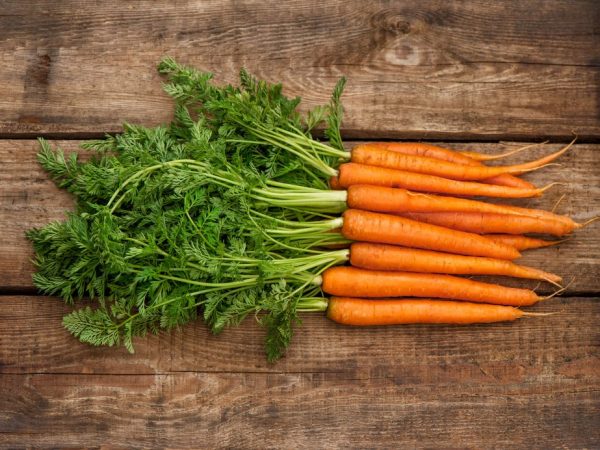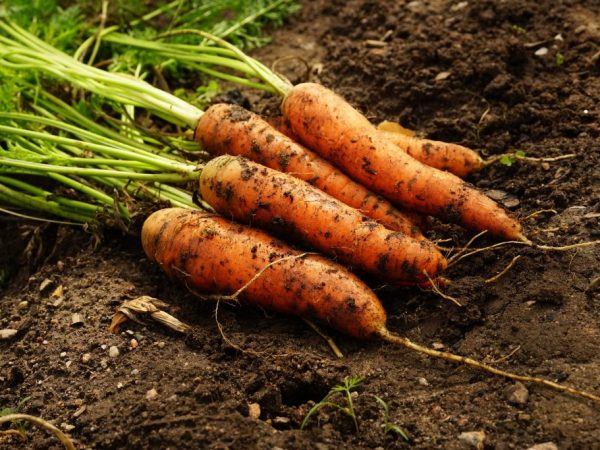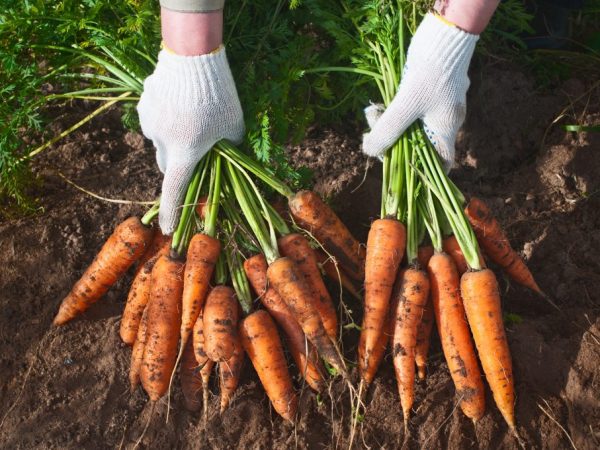Interesting facts about carrots
Carrots are a popular vegetable that has been grown around the world for thousands of years. It contains a lot of nutrients, vitamins, minerals. The root crop is fruitful, undemanding, it is included in the national cuisine of many peoples. The fruit and tops are also used as animal feed.

Interesting facts about carrots
The origin of carrots
Common carrots belong to the Umbellate or Cruciferous family, the Umbrella order and the Dicotyledonous class. One of the closest relatives of the vegetable is cabbage. The plant has been known to people for 4000 years. History has not fully understood the exact origin. Some scholars argue that the culture first appeared in the Mediterranean. Others say that the historical homeland of carrots is Afghanistan, where wild species are still found.
Legend has it that this plant was originally a horse feed. Then one of the beaters decided to try the root, and he liked it. Since then, the vegetable has been grown as a table crop. But archaeological and biological facts disprove myths. The root of wild carrots is bitter, it is unlikely that a person immediately liked the taste. Initially, the tops and seeds were used for food, only over time they began to withdraw sweet root crops.
In ancient Rome and Greece, carrots were a delicacy. In medical treatises, there is a brief description of the use of a vegetable as a medicine. After the era of antiquity, culture in Europe almost disappeared, reappeared in the X-XIII centuries. Who brought her is unknown.
The roots were originally purple or brown. Only then did the orange varieties native to the Middle East displace the blue ones. In Russia, the first mention of recipes with carrots is found in the books of the 16th century. The vegetable gained real popularity in the 19th century.
Nowadays it is difficult to imagine European cuisine without this delicious root vegetable. More than 60% of the agricultural crop is grown in Asia. The first place is occupied by China: 45% of the world's total amount of vegetables is grown here. In Europe - 24.7%, and in North America - 9.7%, Africa accounts for only 4%. The main producing countries are China, Russia, Uzbekistan, Ukraine, Poland and Great Britain.
Description of the species
An annual plant familiar to us, which is most often grown in beds, consists of 2 parts: a thick root and a crown with leaves. In the root vegetable, the following components are distinguished:
- Head or epicotyl. The upper part of the root, from which the tops and flowering shoots sprout, are colored green, dark red or purple.
- Neck. The middle part, without kidneys, with a smooth surface.
- Root. The lower part has thin roots that extend in different directions. It gradually becomes thinner, ends with the main root.
The shape of the carrot root crop is different: narrowed cylindrical, conical and even completely round. Their weight is from 80 g to 200-300 g, the record of some varieties is 0.5 kg.The length of the root is from 10 cm to 30 cm. From above it is covered with a thin peel. It consists of an outer thick layer and a core, this is clearly visible in the section. The ratio of these parts depends on the variety.
Carrot tops grow up to 20-60 cm, looks like a small tree or shrub. The structure is simple, it consists of thick fleshy stems and dissected leaves. The color is bright green, saturated, a specific carrot aroma is felt.
Reproduction of carrots
In vegetable gardens, the plant is cultivated throughout the year to get root crops, although it is biennial. After winter, peduncles or modified stems begin to develop on the head. They grow by the middle of summer. A complex umbellate inflorescence appears at the top, surrounded by dissected green leaves.
The flowers are small, the calyx is excised with small denticles. The color of the petals is white, yellow or reddish. There is a large red flower in the center. The fruits of carrots are called "two-seed", each about 3-5 mm in size. Seeds are oval, elongated, covered with small thorns. The weight of one seed is 1-2.8 g, in one fruit there are 2 pieces. When the carrots have bloomed and the fruits are ripe, the plant dies off.
Carrots bloom for several weeks. The seeds ripen in mid-August (in cold climates, in September). The duration of flowering and ripening of seeds depends on the variety, climate and weather. After collecting, they are dried and placed in a dry, dark place. They remain suitable for planting for 2-3 years. The genetic characteristics of hybrids are not transmitted along with the seeds, therefore it is better to buy the seed of such varieties in stores.
Growing requirements

Carrots vary in appearance and taste
To get a good harvest of vegetables, a number of requirements are taken into account. Carrots are an unpretentious crop, therefore it is not difficult to grow them. A root crop is planted both in spring and in autumn, it all depends on the variety.
The soil
The vegetable grows well on loamy and sandy loam loose soils with a low humus content (about 4%). A good harvest is obtained in cultivated swampy areas. The root crop prefers acidic soils, with a pH of 5.6-7. To form carrots with a high carotene content, they are planted on peat.
The beds must be leveled, only a slight slope is allowed. It is better to raise them to a height of about 25 cm, fluff the ground well. Organic fertilizers are applied in autumn or spring, 2-3 weeks before planting. It is allowed to grow a crop in the same place no more than once every 4-5 years. Good precursors for vegetables are onions, garlic, cabbage.
Temperature
The vegetable is not a heat-loving plant. Seeds germinate at 4 ° C-6 ° C, but the optimum temperature for germination is 18 ° C-20 ° C. Then the first green leaves break through after 2 weeks. They can withstand small frosts on the ground surface.
In autumn, the root crop calmly experiences a drop in temperature to -3 ° C or -4 ° C. For a large and juicy head to form, carrots must grow at a moderate temperature.
Humidity
The vegetable tolerates drought well, but needs intensive watering during the period of seed germination and crown growth. This time takes approximately 50-60 days. The more luxuriant the crown, the larger the root will turn out. The main thing is that all the strength of the plant does not go into building up green mass.
After 50-60 days of vegetation, the root reaches the groundwater, regular watering is no longer necessary. Too close location of water in the soil is also undesirable. If it stands at the level of 60-80 cm, the tops become too branchy, and the roots are bent. With a sharp change from dry to wet soil, carrots crack.
Fertilizers
For normal growth, carrots need fertilizer. Organic matter is applied before planting. Immediately after the emergence of seedlings, mineral fertilizing is applied. A mixture of potassium nitrate, nitrophoska, superphosphate, urea and wood ash is used. Top dressing is repeated monthly.
Carrot varieties
Centuries of vegetable cultivation have led to the emergence of hundreds of varieties and hybrids. Some of them, at first glance, have nothing to do with carrots. Varieties are divided according to several principles. For example, by color:
- orange;
- yellow;
- white;
- purple or blue;
- black.
Orange varieties have the highest carotene and sugar content, which is why they have become very popular.
The timing of ripening also matters. Their classification:
- ultra early;
- early;
- medium early;
- late.
Early varieties are good to eat fresh, they are easy to clean. Mediums are suitable for salads, first and second courses, store well. Late ones are intended for winter storage, they lie until spring and even until the next harvest.

All varieties are individual
According to the shape of the root crop, the varieties are divided into:
- cylindrical;
- conical;
- round.
Cylindrical and cone-shaped are popular, they grow large. Round varieties are not very productive, they are grown only in vegetable gardens, they have no industrial value. But round ones have one good characteristic: they have no equal in sweetness.
Carrots are also available for feed and dining. The forage is large, with lush tops, but contains little sugar and carotene. Often white and yellow varieties are referred to as fodder. The dining group is the largest. The fruits are juicy, sweet, high in beta-carotene.
How to choose a variety
The variety should be chosen based on the growing conditions and goals. In regions with a cold climate, mid-season universal varieties grow well. Varieties with short roots are planted on clay soil: they are easier to collect. For loose soils, species with a long root are suitable. Before buying seeds, it is worth reading the description on the box, they often indicate the requirements for the type of soil, cultivation conditions.
The early varieties will be some of the first vegetables on the table. For giving, unpretentious hybrids with an average yield are chosen. If the groundwater on the site is high, choose varieties that do not crack. In industrial production, the yield and the possibility of machine harvesting, uniform growth and the same size of fruits are important.
The benefits of carrots
The vegetable is a real storehouse of vitamins and minerals, the benefits from it are enormous. The orange color of root vegetables is given by beta-carotene or provitamin A. It is converted into retinol when interacting with fats. Responsible for night vision, maintaining immunity, normal skin and mucous membranes. It is a powerful performance-enhancing antioxidant. After eating 2-3 carrots a day, a person works like a machine.
Carrots have a positive effect on the functioning of the digestive system. It prevents bleeding of the gums, enhances intestinal peristalsis, and prevents constipation. It is recommended to eat it for intestinal infections, since it helps to destroy pathogenic bacteria. The vegetable improves immunity, helps fight colds, cures coughs. There is evidence that it calms the nervous system, relieves the effects of stress.
The root crop is recommended to be eaten every day for female gynecological diseases. It regulates the production of hormones, treats thrush, and normalizes the monthly cycle. In nursing mothers, it increases the quantity and quality of breast milk. It is advised to use fresh and boiled carrots for female and male infertility, erectile dysfunction. It is useful for kidney inflammation, cystitis.
Cosmetologists attribute a rejuvenating effect to carrots. Rejuvenating masks, scrubs and peels are made from juice and pulp. When exposed to air, many useful substances are destroyed, therefore a vegetable face mask or other care product is used immediately after preparation. With regular use of such natural cosmetics, it is easy to rejuvenate.
How to properly peel and consume carrots
The controversy about which carrot is healthier: raw or boiled is still ongoing.More vitamins are stored in raw vegetables, which are quickly destroyed during heat treatment. To get your dose of carotene or ascorbic acid, you need to gnaw on a fresh carrot. It is advised not to even peel young fruits, since the peel is no less useful. But this only applies to vegetables grown with his own hands: the purchased skin contains a lot of nitrates.
In boiled root vegetables, the effect of antioxidants is increased by 15-30%. Substances resist the formation of free radicals and their harmful effects on cells. This reduces the manifestations of inflammation, prevents cancer, and improves well-being. In addition, boiled carrots are indicated for those who have dental problems, gastrointestinal diseases. It is easier to digest, does not discharge the gums, stomach and intestinal mucosa.
To properly peel carrots, it is advised to use special knives or thin-bladed devices. The peel contains many useful substances, so only a thin layer of it needs to be removed. If you boil a whole root in a uniform, the skin will come off by itself. This is how it is recommended to cook a vegetable for salads.
The use of carrots is wide. Dozens of dishes and sauces are prepared from it. Fresh fruits are used to prepare salads. Delicious puree is obtained from grated carrots with an apple, it is good to add a couple of drops of vegetable oil, honey to it. Easily process vegetables into juice. Among industrial juices, this is one of the most popular, especially in baby food.
In combination with garlic, carrots are an indispensable remedy for the prevention of colds. The real taste of French cuisine is in the carrot and onion sauce. It is added to pork, beef, tongue. It turns out to be an interesting sweetish combination. In our kitchen, soups, a traditional Olivier salad, are prepared with an orange vegetable. Uzbek pilaf is not complete without a root crop; yellow varieties are well suited for it.


